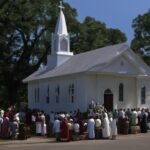The Seventh-day Adventist Church has a rich and fascinating history that dates back to the 19th century. From its humble beginnings as part of the Advent Movement led by William Miller, to its establishment as an independent denomination in 1863, the Adventist Church has grown and flourished over the years. This article will delve into the origins, key beliefs, historical significance, schisms, leadership, worship practices, contemporary influence, and current world membership of the Seventh-day Adventist Church.
Key Takeaways:
- The Seventh-day Adventist Church traces its origins to the 19th-century Advent Movement led by William Miller.
- Ellen G. White, a prominent figure in Adventist history, played a significant role in shaping Adventist beliefs.
- The Adventist Church has distinct key beliefs, including the observance of the seventh-day Sabbath and the recognition of Ellen G. White’s prophetic gift.
- The Church’s emphasis on health, education, and mission work has contributed to its historical significance and contemporary influence.
- Throughout its history, the Adventist Church has experienced denominational splits and schisms resulting in the formation of various Adventist denominations.
- The Church is governed by the General Conference and follows a democratic leadership structure.
- Adventist worship practices center around the observance of the seventh-day Sabbath and include elements such as prayer, Bible study, and hymn singing.
- The Adventist Church continues to have a significant influence in various areas, including healthcare, education, and social initiatives.
- The Adventist Church has a worldwide membership of nearly 22 million baptized members and continues to grow globally.
Origins and Founders of the Adventist Church
The Seventh-day Adventist Church has its origins in the Advent Movement of the early 1800s, led by William Miller. This movement attracted followers who believed in the imminent Second Coming of Christ, based on Miller’s interpretation of biblical prophecy. Among these followers were the pioneers who would go on to found the Adventist Church, including the influential figure of Ellen G. White.
Ellen G. White played a significant role in shaping the beliefs and practices of the early Adventist Church. Recognized as a modern-day prophet, she provided guidance and direction to the early church pioneers through her prophetic gift. Her writings and teachings continue to be influential within the Adventist community to this day.
As the Adventist movement grew, its followers began to separate from other Millerite groups and formed their own denomination. On May 21, 1863, the Seventh-day Adventist Church was officially organized in Battle Creek, Michigan. The founders of the Church, including Ellen G. White and other early pioneers, established the theological foundation and principles that would define the Adventist faith.
“We are a people of destiny, a movement with a mission. God has raised up our church to proclaim the distinctive Advent message to the whole world in preparation for the second coming of Jesus Christ.”
The Adventist Church has its roots in the Advent Movement of the early 1800s, led by William Miller. The movement attracted followers who believed in the imminent Second Coming of Christ. The founders of the Seventh-day Adventist Church, including Ellen G. White, emerged from the Millerite movement and played a crucial role in shaping Adventist beliefs and establishing the denomination. Today, the Adventist Church continues to grow and spread its message of hope and preparation for Christ’s return.
| Key Points | Details |
|---|---|
| Origins | The Adventist Church originated from the Advent Movement led by William Miller in the early 1800s. |
| Founders | The founders of the Adventist Church include Ellen G. White and other early pioneers. |
| Ellen G. White | Ellen G. White had a significant influence in shaping Adventist beliefs through her prophetic gift. |
| Official Organization | The Seventh-day Adventist Church was officially organized on May 21, 1863, in Battle Creek, Michigan. |
Key Beliefs and Doctrines of the Adventist Church
The Adventist Church holds several key beliefs and doctrines that differentiate it from other Christian denominations. These core teachings shape the faith and practices of its members and provide a unique perspective on biblical interpretation.
Seventh-day Sabbath
One of the distinctive beliefs of the Adventist Church is the observance of the seventh-day Sabbath. Adventists believe that the Sabbath, which falls on Saturday, is a holy day set apart by God for worship, rest, and spiritual rejuvenation. They emphasize the importance of keeping this day as a time to honor God and deepen their relationship with Him.
Investigative Judgment
Another notable doctrine of the Adventist Church is the teaching of the investigative judgment. Adventists believe that since 1844, Jesus Christ began a heavenly judgment process to determine the destiny of every individual who has ever lived. This belief is based on the interpretation of prophecy found in Daniel 8:14, which states that the sanctuary would be cleansed after a prophetic time period.
Heavenly Sanctuary
The teaching of the heavenly sanctuary is closely related to the doctrine of the investigative judgment. Adventists believe that Jesus Christ is currently serving as our High Priest in the heavenly sanctuary, ministering on behalf of His people. This understanding of the sanctuary services in the Old Testament is seen as a key to unlocking the meaning behind the sacrificial system and the role of Jesus as the ultimate sacrifice.
Prophetic Gift
Adventists recognize the prophetic gift of Ellen G. White, who played a significant role in the church’s history and development. They believe that God used her as a messenger to provide spiritual guidance, counsel, and instruction to the early Adventist pioneers. Her writings are considered authoritative and are valued for their practical and spiritual insights.
| Belief | Description |
|---|---|
| Seventh-day Sabbath | Adventists observe the seventh-day Sabbath, considering it a sacred time for worship, rest, and spiritual growth. |
| Investigative Judgment | Adventists believe in a heavenly judgment process that began in 1844 to determine the destiny of every individual. |
| Heavenly Sanctuary | Adventists teach that Jesus Christ is currently ministering as our High Priest in the heavenly sanctuary. |
| Prophetic Gift | Adventists recognize the prophetic gift of Ellen G. White and value her writings for spiritual guidance. |
These key beliefs and doctrines form the foundation of Adventist theology and shape the way Adventists approach their faith and practice. They provide a unique perspective on biblical interpretation and guide the actions and principles of the Adventist Church.
Historical Significance of the Adventist Church
The Adventist Church has played a significant role in shaping history, both within the United States and globally. Emerging during the Second Great Awakening in the 19th century, the Church was part of a period of religious revival and social change. This movement had a profound impact on the religious landscape of the time and continues to influence society today.
One of the key contributions of the Adventist Church is its emphasis on health and wellness. From the early days of the Church, Adventists recognized the importance of a holistic approach to health, promoting vegetarianism, exercise, and healthy lifestyle choices. This emphasis on health has had a lasting impact, with the establishment of numerous hospitals and health institutions around the world.
“The Adventist Church’s commitment to health and wellbeing has made a significant impact on public health movements globally.”
The Adventist Church has also made significant contributions to education. It operates a vast network of schools, colleges, and universities that prioritize holistic education, combining academic excellence with a focus on character development and spiritual growth. Adventist educational institutions have produced leaders in various fields and continue to provide quality education for students around the world.
The Impact of the Adventist Church’s Mission Work
Another important aspect of the Adventist Church’s historical significance is its commitment to mission work. The Church has been actively involved in spreading its message and establishing institutions globally. It has built schools, hospitals, and other facilities in many countries, contributing to the development and well-being of communities.
Through its mission work, the Adventist Church has positively impacted the lives of individuals and communities by providing healthcare, education, and social services. This commitment to serving others aligns with the Church’s belief in the importance of practical Christianity and making a difference in the world.
A Summary of the Adventist Church’s Contributions:
| Contributions | Impact |
|---|---|
| Emphasis on health and wellness | Establishment of numerous hospitals and health institutions globally |
| Promotion of holistic education | Operation of schools, colleges, and universities worldwide |
| Mission work and global outreach | Establishment of schools, hospitals, and social service institutions in many countries |
The historical significance of the Adventist Church can be seen not only through its contributions to health, education, and mission work but also through the positive impact it has had on individuals, communities, and society as a whole. As the Church continues to grow and adapt to the changing world, its historical legacy continues to shape its mission and inspire its members to make a difference.
Denominational Split or Schisms in the Adventist Church
The Adventist Church, like many other religious denominations, has experienced its fair share of denominational splits and schisms throughout its history. These divisions have occurred due to various factors, including theological differences and disagreements over interpretation of Adventist beliefs. While the overall goal of these splinter groups is often to maintain a more faithful adherence to certain principles or doctrines, the result has been the formation of distinct Adventist denominations with their own unique beliefs and practices.
One notable split in the Adventist Church occurred in the early 20th century with the formation of the Seventh-day Adventist Church Reform Movement. This group emerged due to differences in understanding the role of Ellen G. White and her prophetic gift. Another significant schism was the development of the Branch Davidians, a group that originated from within the Adventist Church but eventually separated and formed their own distinct community.
These denominational splits and schisms are a natural part of religious history and reflect the diversity of beliefs and interpretations within the Adventist Church. While they may lead to divisions, they also highlight the complexities and evolving nature of religious traditions.
It is important to note that despite these splits, the majority of Adventists remain united under the official organization of the General Conference, which serves as the highest administrative body of the denomination. The General Conference sets policies, coordinates mission work, and provides leadership for the worldwide Adventist Church. While denominational divisions may exist, the overarching mission of spreading the gospel and preparing for the return of Christ remains at the core of Adventist beliefs.
| Denomination | Year of Split | Reason for Split |
|---|---|---|
| Seventh-day Adventist Church Reform Movement | 1925 | Differences in understanding the role of Ellen G. White |
| Branch Davidians | 1955 | Development of unique beliefs and practices |
| Other Adventist Denominations | Various | Theological differences and interpretations of Adventist beliefs |
Despite the existence of these denominational splits, Adventists continue to embrace their shared history and unite around their common beliefs and mission. While the Adventist Church may have experienced divisions over the years, it is the collective impact and influence of the Adventist movement as a whole that has shaped its historical significance and continues to guide its future.
Leadership and Governance of the Adventist Church
The Adventist Church is led and governed by the General Conference, which serves as the highest administrative body of the denomination. The General Conference is responsible for setting policies, coordinating mission work, and providing leadership to the worldwide Church. It is composed of divisions, unions, and local conferences that oversee various aspects of the Church’s operations.
At the highest level of leadership, the General Conference is headed by a President who is elected by delegates from around the world. The President works alongside a team of administrators and department directors to guide the Church’s activities and initiatives. The President and other elected officials serve a specific term and are accountable to the General Conference in their roles.
The leadership structure of the Adventist Church ensures that decisions are made collectively and with representation from different regions and constituencies. This promotes unity and collaboration within the denomination, while also allowing for localized decision-making and initiatives at lower levels of governance.
“The General Conference is the highest authority in our Church. It provides direction and guidance for our worldwide mission and ensures that our beliefs and practices are upheld. It is a privilege to serve in a leadership capacity and contribute to the growth and development of the Adventist Church.”
– Elder John Andrews, General Conference President
Table: Adventist Church Leadership Structure
| Level of Governance | Role |
|---|---|
| General Conference | Oversees worldwide Church operations and sets policies. |
| Divisions | Coordinate Adventist work in various regions. |
| Unions | Administer Church activities within specific countries or territories. |
| Local Conferences | Manage operations and initiatives at the local level. |
The leadership and governance structure of the Adventist Church ensures that the denomination operates efficiently and effectively, with a clear framework for decision-making and implementation of initiatives. It also provides accountability and transparency in the administration of Church affairs, enabling members to have confidence in the leadership and direction of the denomination.
Worship Practices of the Adventist Church
The Adventist Church places a strong emphasis on worshiping on the seventh-day Sabbath, which is observed from Friday sunset to Saturday sunset. This practice stems from the belief that the Sabbath is a sacred day of rest and worship, following the example set in the biblical commandment to remember the Sabbath day and keep it holy.
Adventist worship services commonly include a variety of elements aimed at fostering spiritual growth and community engagement. Bible study is an integral part of Adventist worship, where members gather to explore and discuss the teachings of Scripture. These study sessions provide opportunities for individuals to deepen their understanding of the Bible and its relevance to their daily lives.
Prayer holds a central role in Adventist worship, allowing individuals to communicate with God and seek His guidance and blessings. Both individual and corporate prayer are practiced, with congregations joining together in prayer for various needs and concerns. Personal devotions are also encouraged, with individuals dedicating time each day to reflect, meditate, and pray.
Additionally, Adventist worship services typically include hymn singing, allowing believers to express their faith and devotion through music. Hymns are chosen for their theological depth and spiritual significance, uplifting the congregation and inspiring worship. Sermons form another essential component of Adventist worship, where pastors or church leaders deliver messages rooted in Scripture, addressing relevant spiritual and practical topics.
“Through worship, Adventists seek to honor and glorify God, deepen their spiritual connection, and find inspiration and guidance for their lives. The Sabbath is viewed as a gift from God, providing a weekly opportunity to rest, recharge, and engage in meaningful worship with fellow believers.”
Believer’s baptism by immersion is an important sacrament in the Adventist Church, symbolizing the individual’s commitment to their faith and their desire to follow the example set by Jesus. The Lord’s Supper, also known as Communion, is another significant practice observed by Adventists. During this solemn ceremony, members partake of unleavened bread and grape juice, symbolizing Christ’s body and blood, as a remembrance of His sacrifice on the cross.
Furthermore, Adventists engage in various forms of worship beyond the weekly Sabbath services. Small group studies provide opportunities for deeper fellowship and spiritual growth, with individuals gathering in homes or church settings to delve into the Scriptures and share their faith journeys. Adventists also value the importance of community outreach and service as acts of worship, seeking to make a positive impact in their local communities and beyond.
Table: Sabbath Worship Practices in the Adventist Church
| Worship Element | Description |
|---|---|
| Bible Study | Gathering for the exploration and discussion of biblical teachings. |
| Prayer | Individual and corporate prayer for communication with God and seeking His guidance. |
| Hymn Singing | Expressing faith and devotion through singing hymns of praise and worship. |
| Sermons | Delivering messages rooted in Scripture to address relevant spiritual and practical topics. |
| Believer’s Baptism | Symbolic immersion in water as a commitment to faith and following Christ. |
| Lord’s Supper | Partaking of bread and grape juice as a remembrance of Christ’s sacrifice. |
| Small Group Studies | Fellowship and spiritual growth through shared exploration of the Scriptures. |
| Community Outreach | Engaging in acts of service and making a positive impact in the community. |
Through worship, Adventists seek to honor and glorify God, deepen their spiritual connection, and find inspiration and guidance for their lives. The Sabbath is viewed as a gift from God, providing a weekly opportunity to rest, recharge, and engage in meaningful worship with fellow believers. With a focus on biblical teachings, prayer, praise through music, and sacraments like baptism and Communion, Adventist worship fosters a sense of community and spiritual growth among its members.

Contemporary Influence of the Adventist Church
The Adventist Church continues to have a significant influence in various areas of society. Its focus on health and wellness has led to the establishment of numerous hospitals and health institutions around the world. Adventists believe in the holistic well-being of individuals, promoting not only physical health but also mental, emotional, and spiritual well-being. Through their healthcare institutions, Adventists provide quality medical care and contribute to advancements in the field of medicine.
The Church is also actively involved in education, with universities, colleges, and schools that prioritize holistic education. Adventist educational institutions emphasize the development of the whole person – academically, morally, and spiritually. They strive to provide a safe and nurturing environment for students to grow and succeed.
“The education of children and youth holds a key position in the work of the Adventist Church. It is seen as an essential part of the mission to prepare individuals for responsible citizenship in this world and the world to come.” – Ellen G. White
Additionally, the Adventist Church engages in various social initiatives that positively impact communities globally. Adventists are committed to serving others and making a difference in the lives of those in need. This is evident through their disaster relief efforts, community development programs, and humanitarian aid projects.
| Area of Influence | Examples |
|---|---|
| Healthcare | Establishment of hospitals and health institutions |
| Education | Universities, colleges, and schools prioritizing holistic education |
| Social Initiatives | Disaster relief, community development programs, and humanitarian aid projects |
Furthermore, the Adventist Church utilizes various media platforms to disseminate its message and reach a global audience. Adventist media ministries produce television programs, radio broadcasts, websites, and social media content that provide spiritual guidance, practical advice, and encouragement for individuals in their daily lives.
In summary, the Adventist Church has a significant contemporary influence in various areas, including healthcare, education, social initiatives, and media. Its commitment to holistic well-being, community service, and the dissemination of its message has made a positive impact on society. As the Adventist Church continues to grow and adapt to the needs of the modern world, its influence and contributions are likely to continue shaping the communities it serves.
Current World Membership of the Adventist Church
The Adventist Church boasts a widespread presence across the globe, with its membership steadily growing in numbers. As of the latest data, the current world membership of the Adventist Church stands at nearly 22 million baptized members. This remarkable figure reflects the enduring appeal and influence of the Church’s teachings and principles.
Seventh-day Adventists can be found in over 200 countries and territories, spanning diverse cultures, languages, and traditions. Their mission work and evangelistic efforts continue to bring new converts into the fold, resulting in regular baptisms and an expanding global community of believers.
With a membership of this magnitude, the Adventist Church ranks among the largest Protestant denominations worldwide. Its commitment to spreading the message of hope and salvation has helped establish a strong presence in various regions, cultivating vibrant congregations and establishing important institutions such as schools, hospitals, and humanitarian initiatives.

Conclusion
Summarizing the history and impact of the Adventist Church, we can see how it has evolved from its origins in the 19th century Advent Movement to become a global denomination with a significant influence in society. The Church’s key beliefs and doctrines, such as the observance of the seventh-day Sabbath and the recognition of Ellen G. White’s prophetic gift, have shaped its identity and set it apart from other Christian denominations.
The Adventist Church has made historical contributions through its emphasis on health and education. Its institutions have played a pivotal role in the fields of public health and education, leaving a lasting impact on society. Additionally, the Church’s commitment to mission work has led to the establishment of hospitals, schools, and other institutions around the world.
Although the Adventist Church has experienced denominational splits and schisms, these have also contributed to the formation of various Adventist denominations with their own distinct beliefs and practices. The Church’s leadership and governance are carried out by the General Conference, which provides direction and coordination for the worldwide denomination.
Worship practices within the Adventist Church revolve around the observance of the seventh-day Sabbath and include Bible study, prayer, hymn singing, and a sermon. Believer’s baptism and the celebration of the Lord’s Supper also hold significance. The Church’s contemporary influence is reflected in its focus on health and wellness, contributions to education, social initiatives, and media ministries.
With a current worldwide membership of nearly 22 million baptized members, the Adventist Church continues to grow and spread its message globally. As it moves forward, the Church remains committed to sharing the hope and message of Jesus Christ with the world.
FAQ
When was the Seventh-day Adventist Church officially founded?
The Seventh-day Adventist Church was officially founded in Battle Creek, Michigan on May 21, 1863.
What is the Adventist Church’s origin?
The Adventist Church’s origins can be traced back to the 1830s with the Advent Movement led by William Miller.
Who played a significant role in shaping Adventist beliefs?
Ellen G. White played a significant role in shaping Adventist beliefs and providing guidance through her prophetic gift.
What are some key beliefs and doctrines of the Adventist Church?
Key beliefs and doctrines of the Adventist Church include the observance of the seventh-day Sabbath, the belief in the investigative judgment and the heavenly sanctuary, and the recognition of Ellen G. White’s prophetic gift.
What historical impact has the Adventist Church had?
The Adventist Church emerged during the Second Great Awakening in the 19th century and has had an impact on health and wellness, education, and various social initiatives.
Have there been any denominational splits in the Adventist Church?
Yes, there have been several denominational splits and schisms throughout the history of the Adventist Church.
How is the Adventist Church governed?
The Adventist Church is governed by the General Conference, which is the highest administrative body of the denomination.
What are the worship practices of the Adventist Church?
The Adventist Church places a strong emphasis on worshiping on the seventh-day Sabbath and engages in various worship practices such as Bible study, prayer, hymn singing, and sermons.
What is the contemporary influence of the Adventist Church?
The Adventist Church continues to have a significant influence in areas such as health and wellness, education, social initiatives, and media ministries.
How many members does the Adventist Church have?
The Adventist Church has a worldwide membership of nearly 22 million baptized members.
















